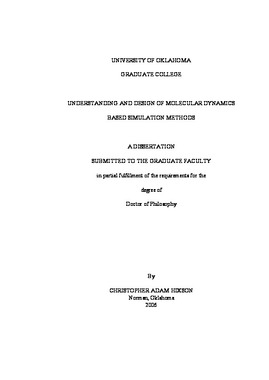| dc.contributor.advisor | Wheeler, Ralph A., | en_US |
| dc.contributor.author | Hixson, Christopher Adam. | en_US |
| dc.date.accessioned | 2013-08-16T12:20:28Z | |
| dc.date.available | 2013-08-16T12:20:28Z | |
| dc.date.issued | 2006 | en_US |
| dc.identifier.uri | https://hdl.handle.net/11244/1129 | |
| dc.description.abstract | Several new strategies for employing modified molecular dynamics (MD) protocols for finding energy minima were developed developed. First, we derived a new method of searching for the lowest energy conformation by employ employing the results of our work to explain "mean mean-field" molecular dynamics simulation methods. Called ensembles extracted by atomic coordinate transformations (EXACT), the method allows simulations to be performed with a variable degree of approximation. Then, we examine the previously published locally enhanced sampling (LES) approximation. The method makes copies of a small part of interest in a larger system, and allows the dynamics to unfold. The method works by making the copies invisible to each other and allowing them to interact only with the remainder of the system, called the bath. The bath, on the other hand, interacts with an averaged representation of the copied part. This averaged interaction allows the copied particles to move into geometries they might not visit in a conventional MD simulation, which allows a greater variety of structures to be sampled. We derive the algorithm by copying the entire system, and then by employing holonomic constraints between the bath particles between the various systems. Using this new approach, we explore several issues previously noted in the literature. We also use the EXACT approximation method to illustrate the nature of the LES approximation. Finally, we present another optimization method, which add adds pressure along with temperature in analogue with simulated annealing. The method is tested against simulated annealing for condensed phase systems of argon, monoglyme, and tetraglyme. The method noticeably improves the results for the glyme systems, but does not seem to hurt the results for the argon system. | en_US |
| dc.format.extent | xiv, 144 leaves : | en_US |
| dc.subject | Simulated annealing (Mathematics) | en_US |
| dc.subject | Molecular dynamics. | en_US |
| dc.subject | Biophysics, General. | en_US |
| dc.subject | Chemistry, Physical. | en_US |
| dc.title | Understanding and design of molecular dynamics based simulation methods. | en_US |
| dc.type | Thesis | en_US |
| dc.thesis.degree | Ph.D. | en_US |
| dc.thesis.degreeDiscipline | Department of Chemistry and Biochemistry | en_US |
| dc.note | Source: Dissertation Abstracts International, Volume: 67-11, Section: B, page: 6422. | en_US |
| dc.note | Adviser: Ralph A. Wheeler. | en_US |
| ou.identifier | (UMI)AAI3242287 | en_US |
| ou.group | College of Arts and Sciences::Department of Chemistry and Biochemistry | |
